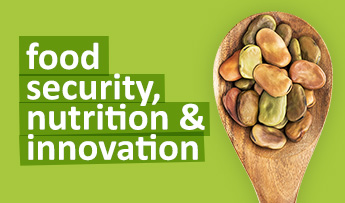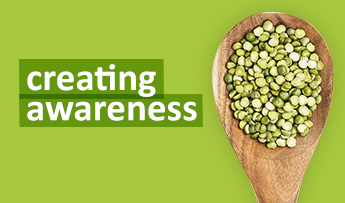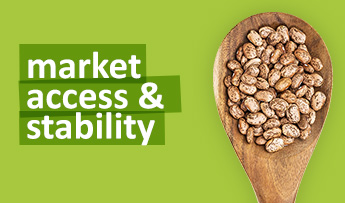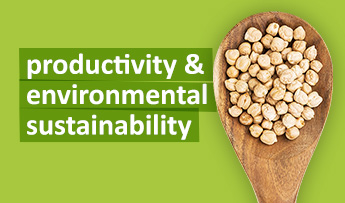Summaries of recent events on the role of pulses for nutrition
Pulses and Nutrition
Pulses are part of a healthy, balanced diet and have been shown to have an important role in preventing illnesses such as cancer, diabetes and heart disease.
Pulses are a low fat source of protein, with a high fibre content and low glycemic index.
Pulses are very high in fibre, containing both soluble and insoluble fibres. Soluble fibre helps to decrease blood cholesterol levels and control blood sugar levels, and insoluble fibre helps with digestion and regularity.
Pulses provide important amounts of vitamins and mineral. Some of the key minerals in pulses include: iron, potassium, magnesium and zinc. Pulses are also particularly abundant in B vitamins; including folate, thiamin and niacin.
Pulses typically contain about twice the amount of protein found in whole grain cereals like wheat, oats, barley and rice, and in most developing countries constitute the main source of protein for most populations.
In addition to contributing to a healthy, balanced diet, pulses nutritional qualities makes them particularly helpful in the fight against some non-communicable diseases.
The World Health Organisation estimates that up to 80% of heart disease, stroke, and type 2 diabetes and over a third of cancers could be prevented by eliminating risk factors, such as unhealthy diets and promoting better eating habits, of which pulses are an essential component.
Pulses can help lower blood cholesterol and attenuate blood glucose, which is a key factors in against diabetes and cardiovascular disease. Eating pulses as a replacement to some animal protein also helps limit the intake of saturated fats and increases the intake of fibres.
Pulses have also been shown to be helpful in the prevention of certain cancers, because of their fibre content but also because of their mineral and amino-acid contents, in particular folate.
Pulses are included in all ‘food baskets’ and dietary guidelines. The World Food Programme (WFP) for instance includes 60 grams of pulses in its typical food basket, alongside cereals, oils and sugar and salt.
Encouraging awareness of the nutritional value of pulses can help consumers adopt healthier diets. In developing countries, where the trend in dietary choices tends to go towards more animal based protein and cereals, retaining pulses is an important way to ensure diets remain balanced and to avoid the increase in non-communicable disease often associated with diet transitions and rising incomes.
Several studies have shown that legumes are been associated with long-lived food cultures such as the Japanese (soy, tofu, natto, miso), the Swedes (brown beans, peas), and the Mediterranean people (lentils, chickpeas, white beans) and that they could be an important dietary factor in improving longevity.
Resources
WHO (2008) 2008-2013 Action Plan for the Global Strategy for the Prevention and Control of Non-communicable Diseases. http://whqlibdoc.who.int/publications/2009/9789241597418_eng.pdf
Pulse Canada: http://www.pulsecanada.com/food-health
Darmadi, Irene and al. (2004) Legumes: the most important dietary predictor of survival in older people of different ethnicities, Asia Pacific J Clin Nutr;13 (2):217-220
S. W. Rizkalla, F. Bellisle and G. Slama (2002). Health benefits of low glycaemic index foods, such as pulses, in diabetic patients and healthy individuals. British Journal of Nutrition, 88, pp 255-262
Julianne Curran (2012). A pulse-based diet is effective for reducing total and LDL-cholesterol in older adults. British Journal of Nutrition, 108, pp S1-S2
Food Research International (2010) Molecular, Functional and Processing Characteristics of Whole Pulses and Pulse Fractions and their Emerging Food and Nutraceutical Applications. Volume 43, Issue 2, Pages 397-664
Grains and Legumes Nutrition Council (2011) Lifting the Lid on Legumes: a guide to the benefits of legumes. http://www.glnc.org.au
Pulses & Food Security
Over 60 percent of total utilisation of pulses is for human consumption. But the importance of pulses in human diets varies from region to region and country to country, with a general trend of higher consumption in lower income nations. The share of food use in total utilisation of pulses in the developing countries is over 75 percent, compared to 25 percent in the developed countries.
In Odendo, M., Bationo, A., Kimani, S., (2011)
Pulses, especially dry peas, are also used as feedstuff. Some 25 percent of pulse total use goes to feeding animals, namely pigs and poultry. Complementing animal feed with improved varieties of pulses has shown to significantly improve animal nutrition too, yielding better livestock, which in turns supports food security. A study in West Africa showed that animals fed cowpea hay, along with rice feed meal, during the dry season gain 95kg, compared to 62kg for animals that did not receive the cowpea fodder. The manure was also of improved quality and the study estimated that farmers which used cowpea fodder could benefit from an extra 50kg of meat a year and over 300kg of cereal grain from the improved soil quality.
Pulses are locally adapted and can be grown by local farmers for their own nutrition as well as for sale, which is important to improve food security. They are highly accepted crops, which can keep well in storage.
Pulses, because of their role in improving sustainability, notably through soil management, also impact food security. Soil degradation is a major threat to food security in many areas. Africa is particularly impacted by soil degradation, yet pulses are part of traditional diets and often grown by small farmers. By improving the crop patterns using pulses, farmers can improve their yields and limit the long-term threat to food security that soil degradation represents.
http://www.ifpri.org/publication/soil-degradation
Pulse Yields (FAOSTAT)
There is a very significant yield gap in pulses in many developing countries – productivity is low and improving it could help enhance food security tremendously. The average global yield for pulses in 2010 was estimated at 819kg/ha. India’s yields were even lower, at 600kg/ha while Canada and the US had yields more than three times that of India, at around 1800kg/ha. France achieves an even higher yield, of around 3800kg/ha, albeit on a much smaller planted surface.
Resources
Scherr, Sarah (1999) Soil Degradation: A Threat to Developing-Country Food Security by 2020? IFPRI http://www.ifpri.org/sites/default/files/publications/pubs_2020_dp_dp27.pdf
Progress H. Nyanga (2012) Food Security, Conservation Agriculture and Pulses: Evidence from Smallholder Farmers in Zambia. Journal of Food Research, Vol. 1, No. 2
Odendo, M., Bationo, A., & Kimani, S. (2011). Socio-Economic Contribution of Legumes to Livelihoods in Sub-Saharan Africa. http://link.springer.com/chapter/10.1007/978-94-007-1536-3_2?null
World Food Programme http://www.wfp.org/nutrition/wfp-foodbasket





